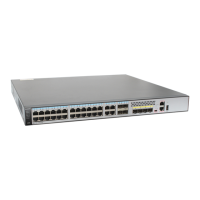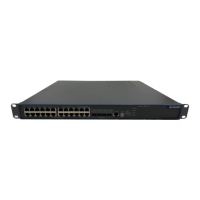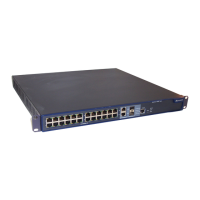2. Configure the basic MPLS functions on the backbone network and set up an LSP tunnel.
Set up MPLS LDP peer relations between U-PE1 and S-PE, and between U-PE2 and S-
PE.
3. Create an MPLS L2VC connection between the two U-PEs.
4. Create a switching PW on the switching node S-PE.
5. Configure a PWE3 Trace test on the multi-hop PW on U-PE1.
Data Preparation
To complete the configuration, you need the following data:
l L2VC IDs on U-PE1 and U-PE2, which must be different
l MPLS LSR-IDs of U-PE1, S-PE, and U-PE2
l IP address of the remote peer
l Encapsulation type of the switching PW
l Name and parameters of the PW template on U-PE devices
Procedure
Step 1 Configure a dynamic multi-hop PW.
Configure a dynamic multi-hop PW on the MPLS backbone network.
For the detailed configuration procedure, see "PWE3 Configuration" in the Quidway S5700
Series Ethernet Switches Configuration Guide - VPN.
Step 2 Configure a PWE3 Trace test of the multi-hop PW.
# Configure U-PE1.
<U-PE1> system-view
[U-PE1] nqa test-instance test pwe3trace
[U-PE1-nqa-test-pwe3trace] test-type pwe3trace
[U-PE1-nqa-test-pwe3trace] local-pw-id 100
[U-PE1-nqa-test-pwe3trace] local-pw-type ppp
[U-PE1-nqa-test-pwe3trace] label-type control-word
[U-PE1-nqa-test-pwe3trace] remote-pw-id 200
Step 3 Perform the test.
[U-PE1-nqa-test-pwe3trace] start now
Step 4 Verify the test result.
After running the display nqa history command on the PE device, you can see that the status
is successful.
[U-PE1-nqa-test-pwe3trace] display nqa history
NQA entry(test, pwe3trace)
history:
Index T/H/P Response Status Address Time
1 1/1/1 4 success 10.1.1.2 2006-9-30 9:33:3.301
2 1/1/2 5 success 10.1.1.2 2006-9-30 9:33:3.307
3 1/1/3 3 success 10.1.1.2 2006-9-30 9:33:3.311
4 1/2/1 6 success 20.1.1.2 2006-9-30 9:33:3.318
5 1/2/2 6 success 20.1.1.2 2006-9-30 9:33:3.324
6 1/2/3 6 success 20.1.1.2 2006-9-30 9:33:3.331
7 1/3/1 6 success 30.1.1.2 2006-9-30 9:33:3.318
8 1/3/2 6 success 30.1.1.2 2006-9-30 9:33:3.324
9 1/3/3 6 success 30.1.1.2 2006-9-30 9:33:3.331
Quidway S5700 Series Ethernet Switches
Configuration Guide - Network Management 6 NQA Configuration
Issue 01 (2011-10-26) Huawei Proprietary and Confidential
Copyright © Huawei Technologies Co., Ltd.
380

